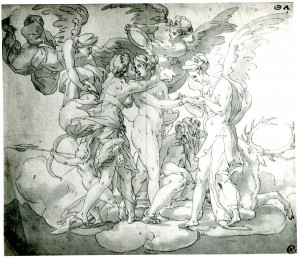Possibly for a fresco in the Galerie Basse of the Pavillon des Poêles, Fontainebleau
1539-1540
Dallas, Carolyn Bullard, Fine Prints and Drawings (in 1993).
Pen and ink and wash, 25.4 x 30.2, the upper and lower left corners missing and added and the upper right corner partly restored; no wm., the paper with widely spaced chain lines. Creased down the center.
PROVENANCE: R. Cosway (Lugt 629). Herbert E. Feist. Unidentified marks upper right (related to Lugt 2942, Netherlands, 17th century), lower left (J.dh or J.Sh), and a paraph at lower left (similar to Lugt 2961, 2962). [Carolyn Bullard informed me that she is suspicious of all the marks except Cosway’s, but that one mark may be for J. Thane (Lugt 2393)]. Sam Cantey III, Fort Worth.
LITERATURE:
School of Fontainebleau, Fort Worth, 1965, 41, 11, as after Rosso.
With standing figures arranged more or less in a file and flying figures descending from above, the composition of this drawing recalls that of Rosso’s Contest of Athena and Poseidon, known from an etching by Fantuzzi (Fig.E.78) and from an engraving attributed to Boyvin (Fig.E.13). At the right in the drawing, the seated old man looks quite like the river god under Poseidon’s horse in the prints, especially in Fantuzzi’s etching. The band held by the central flying figure in the drawing is like the one held by Victory in Boyvin’s engraving, a schematization of a wreath that would later be elaborated by Rosso as in Fantuzzi’s print. Although the female figures in the drawing resemble those in the prints, they are somewhat more similar to certain ones found in the Gallery of Francis I. The full-bodied nude Pandora can be compared with the nude at the far left of the Enlightenment of Francis I (Fig.P.22, VII S a), while the richly dressed Hours and Aphrodite, with their elaborate coiffures, have their counterparts in the Death of Adonis (Fig.P.22, III S a). In the copy in the Fogg Museum (Fig.D.63A) of a lost drawing for the Adonis fresco, the faces of the women are very much like those in the Bullard drawing. The kind of trimming that appears on the edge of Venus’s costume in the Pandora Adorned drawing appears also in the Fogg drawing.
The draughtsmanship of the drawing is of the kind that appears in Rosso’s Throne of Solomon (Fig.D.34) and in his Pandora and Her Box (Fig.D.67a). But the Bullard drawing is not an autograph work, which is clear even in a photograph. Its pen lines are too regular and its washes lack the variety of tones that is found in drawings that are certainly by Rosso himself. Still, the drawing must reproduce quite accurately a lost drawing by him. The original may have had something of the character of the Design for a Tomb in the British Museum (Fig.D.81a), although it was probably not so freely drawn. However, it seems from the copy that the original was not so finished as the Annunciation in the Albertina (Fig.D.43a) or the Petrarch drawing at Christ Church (Fig.D.47a). Graphically, it may have resembled most closely the St. Denis in Berlin (Fig.D.48a), although there is no indication in the Bullard copy that Rosso’s drawing had white highlights.
While the drawing has much in common with the scenes in the Gallery of Francis I, it also has a largeness of form and a compositional breadth and cohesion that differentiate it from them. A certain grandness in the extension and linking of forms relates the drawing to the Pietà in the Louvre (Fig.P.23a), although the Pandora Adorned is not quite so elegant, so spatially closed, or so twisted in the postures of its figures. The composition of the drawing has a kind of amplitude and ease that suggest that it is a later work. In the characteristics just mentioned it is similar to Rosso’s painting in Los Angeles (Fig.P.24a), which may date from the last year of Rosso’s life. But the drawing also shares these qualities with Rosso’s Holy Family with St. Anne, known from a copy in Milan (Fig.D.82), and with his Madonna and Child with a Book, known from an engraving by Boyvin (Fig.E.15). It seems likely, then, that the lost original Pandora Adorned by Aphrodite and the Hours was done about the same time as these compositions, in 1539 or 1540.
The mythological subject of the drawing, derived from Hesiod’s Works and Days,1 and the unusualness of it make one wonder if it was designed for part of a decorative scheme. This scheme could have been devoted to the story of Pandora, but it might also have been devised around some other theme in which a scene or scenes of the Pandora story found their place. The drawing could possibly have been made for the decoration of the Galerie Basse in the Pavillon des Poêles at Fontainebleau, on which Rosso was working at the time of his death, but which he might have begun the year before (see L.44).

